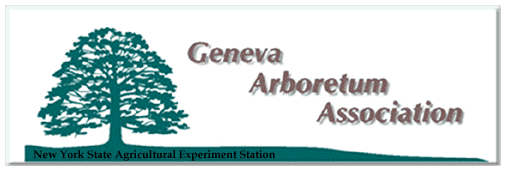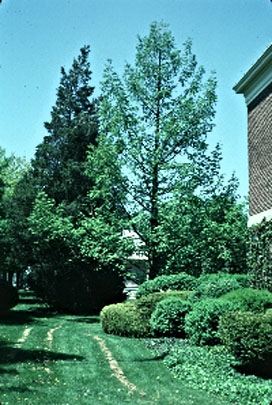

Have you seen our campus redwood "stand"? The large tree at the left corner of Jordan hall as you face the front of the building is Dawn redwood or Metasequoia glyptostrobiodes. Its leaves are now a rusty bronze and ready to fall.
 The
Station was known in the past for its conifer collection, or "pinetum,"
remnants of which are still visible on the corner of Pre-Emption Road and
North Street. Many of our more rare evergreen specimens were donated by
Claude Heit, former Seed Laboratory Director, from his nursery on Lyceum
Street, such as the row of pines in front of the HS greenhouses. Regretfully,
our "last stand" Giant redwood, donated by Don Johnson (B&P)
and grown from seed he brought from California, was lost recently (Campus
warehouse lawn). The Arboretum Group hopes to continue to add to our collection
this valuable group of plants in the future.
The
Station was known in the past for its conifer collection, or "pinetum,"
remnants of which are still visible on the corner of Pre-Emption Road and
North Street. Many of our more rare evergreen specimens were donated by
Claude Heit, former Seed Laboratory Director, from his nursery on Lyceum
Street, such as the row of pines in front of the HS greenhouses. Regretfully,
our "last stand" Giant redwood, donated by Don Johnson (B&P)
and grown from seed he brought from California, was lost recently (Campus
warehouse lawn). The Arboretum Group hopes to continue to add to our collection
this valuable group of plants in the future.
Our Dawn redwood is a relatively new arrival to this country and was unknown elsewhere in the world except for fossil records until recently. Records show that this tree, along with it's cousin Sequoia sempervirens, the Coast redwood, occurred throughout much of the Northern hemisphere during the mid-Tertiary period. Four live Dawn redwood trees were discovered in the interior of China (eastern Szechuan and western Hupeh provinces) in 1941, and a grant from the Arnold Arboretum funded a trip to bring back seeds of this species. The seedlings from those seeds showed great variability in form, with the pyramidal shape "National" (which can be seen in the National Arboretum in Washington DC) being the most popular. Perhaps our tree came from some seeds of this specimen! Today, Dawn, Coast and Giant redwoods are making their "last stands" in China and California. But back to our "last stand" here in Geneva!
Dawn redwood is a member of the conifer or evergreen group of trees which produce their seeds in cones. As an "evergreen," however, Dawn Redwood does not live up to its name as do our native pines or spruces. The tree is deciduous like maples or oaks, loosing its leaves in the fall after they turn a coppery yellow-red color. Actually, even the "true" evergreens loose their leaves (needles) after a year or more.
M. glyptostrobiodes is a fast growing tree within the Taxodiaceae, or Bald cypress family. Like Bald cypress, M. glyptostrobiodes develops a typical broad lower trunk or buttress. The Dawn redwood is a member of the Pinales, a plant group containing many of our more common conifers, several of which can be found on our campus. How many have you already spotted? Watch for more "Trees at a Glance" and see!
by Cathy Heidenreich
Next (Sweet Gum)
Return to Arboretum Home Page
Return to NYS Agricultural Experiment Station Home Page